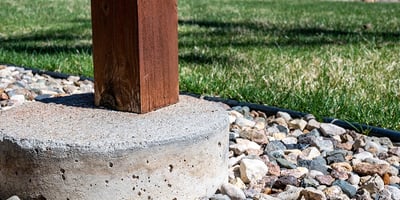In any decking system that you’ll construct, one of the most important parts of the system is the footings. They serve as the foundation for the deck—and they will play a large role in how much weight the deck can support, and how long that deck will last before needing major repairs.
We’re going to dive deep into this topic so that you can learn more about different types of deck footings. Plus, we’re going to look at the SCRAIL® InvisiDeck® System manufactured by BECK, which is an innovative fastener system designed exclusively for creating beautifully finished decks. Let’s get started!
What Are Deck Footings?
Deck footings are where the deck connects to the ground below. Historically, most decks have relied on a buried post footing, which is where the deck posts are buried below ground, with a cement footing that is below the frost line. The cement serves to anchor the post in place, and you end up with a relatively seamless look—nothing above ground except for the post.
Over time, builders have developed new types of deck footings. The biggest reason why is that there is a major failure point where the deck posts contact the ground. The prolonged moisture will cause higher maintenance concerns and eventually lead to rot, even when using treated lumber. Even though the rest of the deck may still be in great shape, rotted posts can lead to structural instability or even collapse. Thus, builders now often use other types of deck footings to prevent this problem.
Types of Deck Footings
We discussed traditional cement footings above—but there are a few other types of deck footings to be aware of. These include:
- Precast Concrete Footings: These are precast, stackable concrete blocks designed to be dropped into holes so that you can anchor deck posts to the top of the footing. These are typically quite easy to install since you don’t need to wait for concrete to cure.
- Deck Blocks: Deck blocks are probably the easiest type of footing to install. These are square blocks with slots in the top designed to anchor the deck posts. There is less digging involved with these since you typically bury them just below the ground’s surface.
- Tube Piers: These are also generally an easier type of footing to install. Builders simply bury a tube, then fill it with concrete to create a solid, stable footing. Bell piers are a cousin to tube piers—but they feature a bell shape to help better spread out the load of the deck. Deck posts are typically fastened to the top of the pier, which is above ground level.
- Screw Piles: Screw piles need specialized hydraulic machinery to install them—which makes them the most expensive option. However, they’re also among the strongest footings, and for the price, they’re very easy to install since no digging is required.
These are some of the most popular types of deck footings used today. To choose between them, you’ll need to analyze factors like deck height, the composition of the ground below, and more. For instance, deck blocks are typically used for ground-level decks whereas taller decks will need buried post footings or another type of footing to make them structurally sound.
Choose the Right Tools to Build the Perfect Deck
Choosing footings is only one part of the job. You’ll also need a reliable fastener system—and the SCRAIL® InvisiDeck® System is the right choice. What makes InvisiDeck® special is that it’s a blind fastener system, which means that you can quickly and easily install hidden fasteners to create a deck that has a trendy, seamless look.
This system is designed to drive plastic strip SCRAIL® fasteners at an angle along the sides of each plank instead of through the plank’s surface. You can install fasteners up to five times faster with this system—and with no damage to the surface of the decking boards.
Click below and get your copy of the product brochure, offering all the information you need to know about this fastening system, and how it is the perfect choice for your decking needs!
.svg.png)


